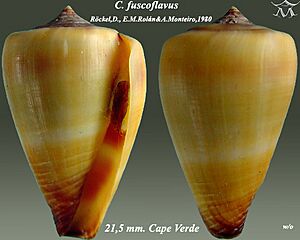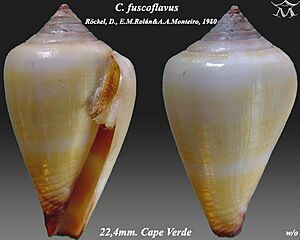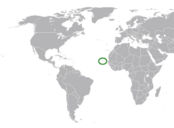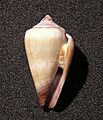Conus fuscoflavus facts for kids
Conus fuscoflavus is a type of sea snail that lives in the ocean. It's a marine gastropod, which means it's a kind of mollusk that usually has a single shell, like a snail. This specific snail belongs to the Conidae family, also known as the cone snails. These snails are special because they have a unique cone-shaped shell.
You can find Conus fuscoflavus only around the Cape Verdes islands in the Atlantic Ocean. Scientists named this species in 1980.
Like all cone snails, Conus fuscoflavus is a predatory animal, meaning it hunts other small creatures for food. They are also venomous, which means they can sting. Because of this, it's very important to be careful and avoid touching live cone snails.
Quick facts for kids Conus fuscoflavus |
|
|---|---|
 |
|
| Apertural and abapertural views of shell of Conus fuscoflavus Röckel, Rolán, & Monteiro, 1980 | |
 |
|
| Conservation status | |
| Scientific classification | |
| Synonyms | |
|
Contents
What Does the Conus fuscoflavus Look Like?
The shell of an adult Conus fuscoflavus can be anywhere from 15 to 28 millimeters long (about 0.6 to 1.1 inches). That's roughly the size of a small button or a large paperclip!
The shell is smooth and thick. It has a main body part called the body whorl that makes up most of its length. The opening of the shell, called the aperture, is long and narrow. It goes all the way down to the bottom of the shell.
This snail also has a small lid, called an operculum, which helps it close off its shell. The shell's color often varies, but it's usually beige or tan with white bands going across it.
Where Does the Conus fuscoflavus Live?

This marine snail lives only in the Atlantic Ocean, specifically around the Cape Verdes islands. These islands are off the coast of West Africa.
The first place this species was officially found and described was in Boa Vista, one of the Cape Verdes islands.
Scientists don't know a lot about the exact places Conus fuscoflavus likes to live or how deep in the water it usually stays. However, other types of Conus snails are known to live in waters from about 200 meters (656 feet) deep down to 1,000 meters (3,280 feet) deep.
Want to Learn More?
- Cone snails
- Conidae
- Conus
- Conus pelagicus
Images for kids






